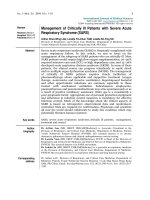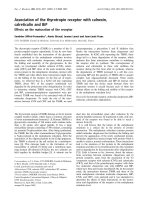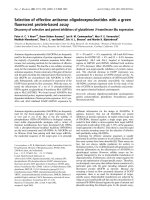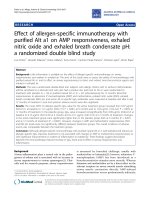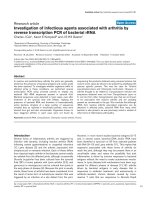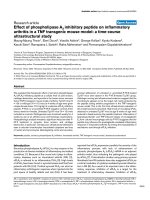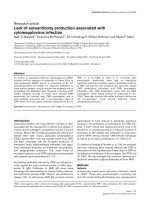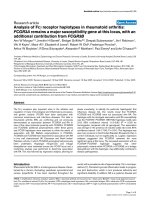Báo cáo y học: "Risk of acute myocardial infarction with nonselective non-steroidal anti-inflammatory drugs: a meta-analysis" ppsx
Bạn đang xem bản rút gọn của tài liệu. Xem và tải ngay bản đầy đủ của tài liệu tại đây (346.73 KB, 9 trang )
Open Access
Available online />Page 1 of 9
(page number not for citation purposes)
Vol 8 No 5
Research article
Risk of acute myocardial infarction with nonselective
non-steroidal anti-inflammatory drugs: a meta-analysis
Gurkirpal Singh
1,2
, Olivia Wu
3
, Peter Langhorne
4
and Rajan Madhok
5
1
Division of Gastroenterology and Hepatology, Stanford University School of Medicine, 100 Hamilton Avenue, Suite 225 #42, Palo Alto, CA, 94301,
USA
2
Institute of Clinical Outcomes Research and Education, 100 Hamilton Avenue, Suite 225 #42, Palo Alto, CA, 94301, USA
3
Division of Developmental Medicine, University of Glasgow, Glasgow Royal Infirmary, Castle Street, Glasgow, G4 0SF, UK
4
Division of Cardiovascular Medicine and Medical Sciences, University of Glasgow, Glasgow Royal Infirmary, Castle Street, Glasgow, G4 0SF, UK
5
Centre for Rheumatic Diseases, Glasgow Royal Infirmary, Castle Street, Glasgow, G4 0SF, UK
Corresponding author: Gurkirpal Singh,
Received: 5 Jun 2006 Revisions requested: 29 Jun 2006 Revisions received: 29 Aug 2006 Accepted: 22 Sep 2006 Published: 22 Sep 2006
Arthritis Research & Therapy 2006, 8:R153 (doi:10.1186/ar2047)
This article is online at: />© 2006 Singh et al.; licensee BioMed Central Ltd.
This is an open access article distributed under the terms of the Creative Commons Attribution License ( />),
which permits unrestricted use, distribution, and reproduction in any medium, provided the original work is properly cited.
Abstract
The use of cyclo-oxygenase 2 selective nonsteroidal anti-
inflammatory drugs (NSAIDs) is associated with increased risk
of acute myocardial infarction (AMI). The association between
the risks of AMI with nonselective NSAIDs is less clear. We
reviewed the published evidence and assessed the risk of AMI
with nonselective NSAIDs. We performed a meta-analysis of all
studies containing data from population databases that
compared the risk of AMI in NSAID users with that in non-users
or remote NSAID users. The primary outcome was objectively
confirmed AMI. Fourteen studies met predefined criteria for
inclusion in the meta-analysis. Nonselective NSAIDs as a class
was associated with increased AMI risk (relative AMI risk 1.19,
95% confidence interval [CI] 1.08 to 1.31). Similar findings
were found with diclofenac (relative AMI risk 1.38, 95% CI
1.22–1.57) and ibuprofen (relative AMI risk 1.11, 95% CI 1.06
to 1.17). However, this effect was not observed with naproxen
(relative AMI risk 0.99, 95% CI 0.88–1.11). In conclusion,
based on current evidence, there is a general direction of effect,
which suggests that at least some nonselective NSAIDs
increase AMI risk. Analysis based on the limited data available
for individual NSAIDs, including diclofenac and ibuprofen,
supported this finding; however, this was not the case for
naproxen. Nonselective NSAIDs are frequently prescribed, and
so further investigation into the risk of AMI is warranted because
the potential for harm can be substantial.
Introduction
One of the most revelatory issues concerning pharmaceuticals
in recent years has been the relationship found between selec-
tive cyclo-oxygenase (COX)-2 inhibitors and cardiovascular
thrombotic adverse events such as acute myocardial infarction
(AMI) [1-5]. Received wisdom has never implicated the older
class of similarly acting drugs, the nonsteroidal anti-inflamma-
tory drugs (NSAIDs), in this association. However, new evi-
dence suggests that there be an association between these
nonselective NSAIDs and cardiovascular adverse effects, and
that the risk may be similar with this class of drugs to that with
COX-2 selective NSAIDs [6].
NSAIDs are among the most popular of prescribed drugs and
have proven effectiveness in relieving symptoms of inflamma-
tion, including pain; they may also have a role in cancer preven-
tion [7]. Both their benefits and adverse effects are due to the
inhibition of either COX-1 or COX-2 enzymes. NSAIDs inhibit
both COX-1 and COX-2, with extent of inhibition of COX-1
versus COX-2 differing between NSAIDs [8]. It is believed that
the NSAID-induced inhibition of COX-1 in the gastrointestinal
mucosa leads to the development of serious gastrointestinal
complications such as ulcers and bleeds. The selective COX-
2 inhibitors were developed to inhibit preferentially the COX-2
enzyme while sparing COX-1, with the premise that this would
prevent serious gastrointestinal toxicity. However, recent stud-
ies have shown an unequivocal increase in risk of cardiovascu-
lar thrombotic events in patients treated with these drugs [1-
5].
AMI = acute myocardial infarction; CI = confidence intervals; COX = cyclo-oxygenase; NSAID = nonsteroidal anti-inflammatory drug.
Arthritis Research & Therapy Vol 8 No 5 Singh et al.
Page 2 of 9
(page number not for citation purposes)
It is unclear whether the greater risk of AMI seen with selective
COX-2 inhibitors is a 'class' effect of all NSAIDs. Like aspirin,
nonselective NSAIDs inhibit COX-1, albeit temporarily, and
they have generally been assumed to be antithrombotic or to
have no cardiovascular adverse effect [8]. More recent studies
suggest that many NSAIDs, both selective and nonselective,
may result in an excess of AMIs [6]. In view of the large num-
bers of patients prescribed nonselective NSAIDs, we
reviewed the available evidence and report the results of a
meta-analysis conducted to determine whether nonselective
NSAIDs increase AMI risk.
Materials and methods
Search strategy
We searched all major electronic databases including
Medline, BIDS and EMBASE, between January 1980 and
June 2005. Relevant keywords (as MeSH terms and text
words) relating to NSAIDs (for instance, anti-inflammatory
agents, non steroidal anti-inflammatory) and AMI (for instance,
myocardial infarction, myocardial ischemia, cardiac ischemia,
death) were combined to capture all potentially relevant stud-
ies. In addition, we contacted experts in the area and reviewed
relevant discussions of the US Food and Drug Administration
advisory panels and the UK National Institute of Clinical Excel-
lence. Hand searching the reference lists of all relevant papers
and recent topic reviews was also carried out.
Study selection
Two reviewers assessed the studies retrieved from the search
independently by scanning all the titles and abstracts. Full text
copies of the selected papers were obtained and scrutinised
independently by both reviewers for inclusion. Studies were
included if they met the following criteria. The design of
included studies was required to be observational studies of
data from population databases that included comparison of
NSAID use and non-use or remote-NSAID use. The interven-
tion has to be use of nonselective NSAIDs. Comparison
groups were required to be current NSAID users along with
non-users or remote users. Finally, the outcome was required
to be objectively confirmed AMI.
Data extraction and quality assessment
Data from studies meeting the inclusion criteria were extracted
into standardized data extraction forms independently by two
reviewers (GS and RM), during which the quality of the studies
was also assessed. This systematic review included a variety
of study types. In order to maintain consistency of reporting, a
validated generic checklist designed for evaluation of quantita-
tive studies was used to assess the quality of all of the studies
included in the review [9]. This checklist originally included 14
criteria, but one of these referred to random allocation of treat-
ment and another referred to the blinding of participants.
These were considered not applicable to observational stud-
ies and were excluded from the checklist; therefore, the final
checklist consisted of 12 items. These items are consistent
with the recommendations from the Centre for Reviews and
Dissemination [10] and the consensus statement on meta-
analysis reporting of observational studies in epidemiology
[11]. Any disagreement relating to inclusion of studies, data
extraction, or quality assessment between the reviewers was
resolved by discussion.
Data synthesis
We performed a meta-analysis using the random effects
model based on the generic inverse variance method on non-
selective NSAIDs as a class, and where data were available
meta-analyses on individual NSAIDs were also carried out. The
random effects model accounts for interstudy variance and
provides a more conservative estimate of effect than does the
fixed effect model, whereas the generic variance method can
take into account confounding by combining adjusted relative
risk estimates [12]. A pooled generic measure of relative AMI
risk was calculated from the individual studies' estimates of rel-
ative AMI risk (expressed in relative risks and odds ratios) and
95% confidence intervals (CIs). We used the assumption that
Figure 1
Selection of studies included in the meta-analysisSelection of studies included in the meta-analysis.
Available online />Page 3 of 9
(page number not for citation purposes)
Table 1
Characteristics of included studies
Ref. Design Data source NSAID exposure Study outcome AMI events (n) No AMI events (n) Confounding factors
[19] Nested case control GPRD (UK) Current NSAID users:
patients (age 50–84
years) whose most
recent prescription
lasted until the index
date or ended in the 30
days before the index
date
First hospitalized
AMI or death due to
CHD
Diclofenac = 213
Ibuprofen = 155
Naproxen = 49
Diclofenac = 679
Ibuprofen = 575
Naproxen = 206
MI risk factors (smoking,
diabetes, hypertension,
hyperlipidemia, BMI, RA,
OA, anemia, CHD, CVD),
age, sex, calendar year,
alcohol intake, and use of
steroids, aspirin,
anticoagulants,
paracetamol, and NSAIDs
[17] Nested case control GPRD (UK) Current NSAID users:
menopausal women
(age 50–74 years) who
had a prescription for
NSAIDs before the index
date
First hospitalized
AMI
Nonaspirin NSAIDs
= 40
Nonaspirin NSAIDs
= 143
Age, use of HRT, smoking,
hypertension, diabetes,
obesity, surgical
menopause, family history
of CHD, and predefined
co-morbidity
[20] Nested case control Managed care
database (USA)
Current NSAID users:
patients (age 18–84
years) who had ≥1
prescription for a COX 2
selective or non-
selective NSAID
Hospitalized AMI,
sudden cardiac
death
Ibuprofen = 670
Naproxen = 367
Ibuprofen = 2573
Naproxen = 1409
Sex, age, geographic
location, cardiovascular risk
score, admission for
noncardiac-related
disorders and same-day
procedures, emergency
room visits for
noncardiovascular reasons,
HRT, and high-dose
prednisolone
[6] Nested case control QRESEARCH
(UK)
Current NSAID users:
patients (age 25–100
years) who had a
prescription for selective
or nonselective NSAIDs
within the 3 months
before the index data
First hospitalized
AMI/CHD, sudden
death
Ibuprofen = 460
Naproxen = 96
Other nonselective
NSAIDs = 181
Ibuprofen = 3199
Naproxen = 677
Other nonselective
NSAIDs = 1266
Use of aspirin, statin,
tricyclic antidepressants,
SSRI, ischemic heart
disease, diabetes,
hypertension, OA, RA,
smoking obesity, and
deprivation
[21] Case control Hospital discharge
registry (Denmark)
Current nonaspirin
NSAID users: patients
(age 20–101 years) who
had received a
prescription within 30
days before the index
date
First hospitalized
AMI
Naproxen = 26
Other nonaspirin
NSAIDs = 532
Naproxen = 175
Other nonaspirin
NSAIDs = 3105
Discharge diagnosis of
CVD, hypertension,
diabetes, chronic bronchitis
or emphysema, acholoism,
liver cirrhosis, upper GI
bleed, RA, systemic lupus
erythematosus and use of
high-dose aspirin, platelet
inhibitors, insulin or oral
hypoglycemic drugs,
antihypertensive drugs,
lipid-lowering drugs, oral
anticoagulants, hormone
therapy, nitrates,
penicillamine, gold and
glucocorticocoids before
date of admission
[22] Nested case control Administrative
health database
(Québec, Canada)
New NSAID users:
patients (age ≥66 years)
who had a dispensed
prescription with a
duration that covered or
overlapped with the
index date
First Hospitalized
AMI
Naproxen = 23
Other nonselective,
nonaspirin NSAIDs
= 51
Naproxen = 336
Other nonselective,
nonaspirin NSAIDs
= 962
Age, sex, hypertension,
CAD, cerebrovascular
disease, peripheral
vascular disease, CCF,
statin, aspirin,
anticoagulants, presence of
respiratory disease, GI
ulcer disease, thyroid
disease, depression or
psychiatric illness, use of
oral corticosteroids,
Chronic disease score,
Charlson index, health care
utilization
[23] Retrospective
cohort
Administrative
health database
(Ontario, Canada)
New NSAID users:
patients (age ≥66 years)
who received a
prescription for NSAIDs
Hospitalized AMI Naproxen = 15
Other nonselective,
non-naproxen
NSAIDs = 134
Naproxen = 5654
Other nonselective,
nonaspirin NSAIDs
= 33,734
Hospitalization in prior year,
malignancy in prior 5 years,
MI, stroke, CAD or CABG
in prior 5 years, age, sex,
long-term care, low income,
number of different drugs
[24] Retrospective
cohort
Tennessee
Medicaid (USA)
New nonaspirin NSAID
users: patients (age 50–
84 years) who had a
prescription of NSAIDs,
with no use during the
previous 365 days
Hospitalized AMI or
death from CHD
Ibuprofen = 339
Naproxen = 201
Other or multiple
nonaspirin NSAIDs
= 301
Data not available Prescribed drugs for CVS
disease, hospital
admissions and emergency
visits for CVS and other
disease, PVD, CVD, CAD,
and revascularization
procedures
Arthritis Research & Therapy Vol 8 No 5 Singh et al.
Page 4 of 9
(page number not for citation purposes)
when the outcome of interest is rare, odds ratio approximates
the relative risk. Potential sources of heterogeneity were inves-
tigated and assessed using the standard χ
2
test. In addition,
the I
2
statistic was used to evaluate inconsistencies in results
reported among the studies. In addition, we assessed publica-
tion bias graphically by using a funnel plot. Sensitivity analysis
was carried out to assess the robustness of the results of the
meta-analysis and to explore heterogeneity. All analyses were
performed using RevMan 4.2 (Cochrane Collaboration,
Oxford, UK).
Results
The search strategy identified 243 potentially relevant cita-
tions for review (Figure 1). On reviewing retrieved papers, two
were based on patient recall and thus were likely to be subject
to reverse recall bias and were excluded [13,14]. A further two
studies were identified by hand searching [15,16], of which
one was excluded because it compared the effects of one
NSAID with current use of three other NSAIDs but it did not
have a control population of remote users or non-users [15].
Fourteen studies contained relevant data and were included in
the analysis [4,16-28], and their characteristics are summa-
rized in Table 1. All of the studies were based on data from val-
idated databases from Canada, Denmark, the UK, and the
USA. Most studies provided details on AMI risk with nonselec-
tive NSAIDs as a group, but some included information only on
non-naproxen NSAIDs. Five studies provided information on
dose: in one [19] the effect of dose was examined only in long-
term users (no dose effect was seen); two studies [18,28]
reported no effect of dose; one [27] reported greater risk of
AMI with higher doses; and one study [24] reported a dose-
dependent effect of ibuprofen but no effect with other
NSAIDs. The duration of exposure in most studies was short
(Table 1). Contrary to the majority of the studies included in
the review, two studies were conducted in selected popula-
tions; one study [17] included only postmenopausal women
and the other [16] was limited to patients with rheumatoid
arthritis. In only three studies was the indication for prescrip-
tion examined in detail [16,17,19].
[25] Retrospective
cohort
Tennessee
Medicaid (USA)
Current and new NSAID
users: patients (age 50–
84 years) who were
taking NSAIDs at
enrolment were classed
as current users; those
who began use of an
NSAID during the follow-
up period were classed
as new users
Hospitalized AMI or
death from CHD
Current users:
Ibuprofen = 190
Naproxen = 245
New users:
Ibuprofen = 52
Naproxen = 72
Data not available Prescribed drugs for CVS
disease, hospital
admissions and emergency
visits for CVS and other
disease, PVD, CVD, CAD,
and revascularization
procedures
[26] Matched case
control
Administrative
health database
(Québec, Canada)
Current NSAID users:
patients (age ≥65 years)
who had a dispensed
prescription with a
duration that covered or
overlapped with the
index date
First AMI Naproxen = 255
Other NSAIDs =
1062
Naproxen = 212
Other NSAIDs =
722
Prior use of anticoagulants,
nitrates, lipid lowering
agents, antidiabetic agents,
antihypertensive agents,
prior CVD, presence of co-
morbidity factors
[27] Nested case control GPRD (UK) Current NSAID users:
patients (age ≤75 years)
who had their last
prescription for an
NSAID before the index
date and which ended at
or after the index date
First hospitalized
AMI
Diclofenac = 97
Ibuprofen = 60
Naproxen = 19
Diclofenac = 277
Ibuprofen = 204
Naproxen = 105
Aspirin, BMI, smoking, HRT
[28] Case control Medicaid/Medicare
(New Jersey, USA)
NSAID users: patients
(age ≥60 years) who
had use of prescribed
NSAIDs during the 6
months before the index
date
Hospitalized AMI Ibuprofen = 285
Naproxen = 243
Ibuprofen = 1030
Naproxen = 1094
Hypertension, diabetes,
CCF, and validated co-
morbidity index
[16] Case control GPRD (UK) Current NSAID users:
patients (age 40–79
years) with RA and who
had received a NSAID
prescription during the
30 days before the index
date
First AMI, sudden
death and stroke
Data not available Data not available Adjusted values reported,
but factors that were
adjusted for were not
detailed
[18] Case control GPRD (UK) Current NSAID user:
patients <89 years
whose prescription
overlapped with the
index date
First AMI Nonaspirin NSAID
= 680
Diclofenac = 260
Ibuprofen = 176
Naproxen = 63
Nonaspirin NSAID
= 2339
Diclofenac = 834
Ibuprofen = 656
Naproxen = 251
Adjusted for hypertension,
hyperlipidemia, diabetes,
ischemic heart disease,
BMI, kidney disease, RA,
and aspirin use
AMI, acute myocardial infarction; BMI, body mass index; CABG, coronary artery bypass grafting; CAD, coronary artery disease; CCF, congestive
cardiac failure; CHD, coronary heart disease; COX, cyclo-oxygenase; CVD, cardiovascular disease; CVS, cardiovascular system; GI,
gastrointestinal; GPRD, General Practice Research Database; HRT, hormone replacement therapy; MI, myocardial infarction; NSAID, nonsteroidal
anti-inflammatory drug; OA, osteoarthritis; PVD, peripheral vascular disease; RA, rheumatoid arthritis; SSRI, selective serotonin reuptake inhibitor.
Table 1 (Continued)
Characteristics of included studies
Available online />Page 5 of 9
(page number not for citation purposes)
All of the studies were included in the meta-analysis (Figure 2).
With the exception of one study [22], which reported no effect
of nonselective NSAID use and AMI risk, all studies identified
a similar trend toward increased risk of AMI. The meta-analysis
of nonselective NSAIDs as a class was based on 13 studies
[6,16-23,25-28], because one study presented data only on
specific nonselective NSAIDs as part of an evaluation of the
risks of AMI with COX-2 inhibitors [24]. The results revealed
an AMI risk of 1.19 (95% CI 1.08 to 1.31; P = 0.0006) in
NSAID users when compared with non-users or remote users.
However, there was high between-study heterogeneity (I
2
=
83.8%; P < 0.00001).
Limited data were available on individual NSAIDs (Table 2).
Five studies presented data on diclofenac [6,16,18,19,27]
and reported increased AMI risk with diclofenac use
compared with non-use or remote use of NSAIDs; the pooled
relative AMI risk was 1.38 (95% CI 1.22 to 1.57; P <
0.00001). There was no significant between-study heteroge-
neity (I
2
= 54%; P = 0.08). Nine studies evaluated the associ-
ation between ibuprofen and the risk of AMI [6,16,18-
20,24,25,27,28]. Although the majority of the individual stud-
ies reported nonsignificant risk association, the pooled
analysis identified a relative AMI risk of 1.11 (95% CI 1.06 to
1.17; P = 0.0001). No evidence of heterogeneity was
detected (P = 0.41), and the risk estimates of individual stud-
ies were consistent (I
2
= 3.2%). In contrast, naproxen use was
not found to be associated with increased AMI risk (relative
AMI risk 0.99, 95% CI 0.88 to 1.11; P = 0.99). The studies
included in the analysis yielded conflicting results. Eight stud-
ies [16,18,19,23-25,27,28] indicated that naproxen was not
associated with increased AMI risk, whereas four studies
[6,20-22] suggested that naproxen was associated with
increased risk of AMI. The risk estimated in two of the latter
four studies [6,21] was statistically significant. Overall, signifi-
cant heterogeneity (P = 0.01) and moderate inconsistency (I
2
= 54%) were present among the estimates reported by the
studies.
Sensitivity analysis
Sensitivity analysis was carried out to explore the heterogene-
ity and inconsistencies of the results of the studies included in
the meta-analysis. We first analyzed the nonselective NSAID
data by excluding the two studies based on selected popula-
tions [15,25]; this had little impact on the results of the meta-
analysis (relative AMI risk 1.18, 95% CI 1.05 to 1.33; P =
0.005), and significant heterogeneity remained (P < 0.00001).
One of the studies [21] exhibited a higher than expected risk
of AMI compared with the other studies; the analysis was
therefore repeated with this study's data excluded. The results
showed a relative AMI risk of 1.13 (95% CI 1.07–1.18; P <
0.00001); there was significant heterogeneity (P = 015), and
a small-to-moderate degree of inconsistency remained (I
2
=
30.7%). All of the analyses were also repeated using a fixed
effect model, but there was little change in the results.
Discussion
Considerable scientific and media attention has been directed
at reports that selective COX-2 inhibitors increase AMI risk.
Two selective COX-2 inhibitors have been withdrawn, and the
sales of another have plummeted. However, until recently, little
attention has been focused on the risks associated with use of
the nonselective NSAIDs. Because there is no randomised
controlled study of nonselective NSAIDs large enough to
detect an increase in a common condition such as AMI, an
absence of evidence has been assumed to imply evidence of
absence. Our meta-analysis shows that use of at least some
nonselective NSAIDs is associated with a small but signifi-
cantly increased risk of AMI compared with remote and non-
use. If this small increase is indeed causally related to use of
nonselective NSAIDs, then the implications for public health
policy are considerable because of the large numbers of
patients prescribed these drugs.
We also investigated the relative AMI risk associated with fre-
quently prescribed nonselective NSAIDs, including
diclofenac, ibuprofen, and naproxen, individually. When com-
paring the use of diclofenac and ibuprofen with no or remote
NSAID use, the results supported the presence of increased
risk of AMI, similar to that observed with NSAIDs as a class.
We did not find a significant association between naproxen
use and AMI, but there was significant heterogeneity and mod-
erate inconsistency among the 12 studies. It is possible that
our meta-analysis was confounded by pharmaceutical com-
pany support of several naproxen studies in the wake of the
increased risk of AMI seen with rofecoxib in the VIGOR
(VIOXX GI Outcomes Research) study [29,30]. The increased
risk of AMI observed with rofecoxib in the VIGOR trial was
explained by a purported 'cardioprotective' effect of naproxen.
Several epidemiologic studies were funded by the manufac-
turer of rofecoxib to prove the cardioprotective effect of
naproxen. These studies, included in our meta-analysis, indi-
cate that there was a large cardioprotective effect of naproxen,
unlike most other independently funded studies. This largely
explains the between-study heterogeneity in our analysis, as
previously established by Juni and coworkers [29]. An interim
analysis of an Alzheimer's disease prevention study [31] has
suggested increased risk of AMI in patients treated with
naproxen, but the full data have not yet been released.
It is possible that different NSAIDs may be associated with dif-
ferential increases in risk of AMI. Differences between
NSAIDs, based on their pharmacologic effects, have been pre-
viously described for the risk of gastrointestinal bleeding [32].
However, there are few data available in the literature on the
cardiovascular risk of NSAIDs other than ibuprofen,
diclofenac, and naproxen.
There are several potential limitations to our study, many of
which are inherent to all meta-analysis of observational stud-
ies. The quality of our analysis depends on the data extracted
Arthritis Research & Therapy Vol 8 No 5 Singh et al.
Page 6 of 9
(page number not for citation purposes)
from the original publications; we may thus inherit the prob-
lems of potential bias and confounding by indication inherent
to observational studies. It is possible that sicker patients may
preferentially receive NSAID treatment, and these patients
carry a higher baseline risk of cardiovascular complications
(confounding by indication). All of the observational studies
included in our meta-analysis adjusted for this confounding,
but it is possible that this limitation was not completely elimi-
nated because of unmeasured variables. However, one advan-
tage of observational studies is that they more accurately
reflect the spectrum of patients in clinical practice, and if they
are large enough they can detect rare adverse events or
increased occurrence of a common disorder [33]. Rand-
omized controlled trials are more appropriate for defining effi-
cacy and assigning causality, but their external validity or
generalizability can often be low [34] and they are rarely suffi-
ciently large or long running to identify all adverse events
[35,36]. Although the randomized clinical trial remains the
Table 2
The relative AMI risk associated with the use individual NSAIDs compared with remote or no use.
Drug [ref.] Relative AMI risk 95% CI Test for heterogeneity Test for inconsistency
χ
2
P value I
2
Diclofenac 1.41 1.20–1.65 9.79 0.08 48.9%
[27] 1.38 1.08–1.77
[16] 1.68 1.14–2.48
[19] 1.18 0.99–1.40
[6] 1.55 1.39–1.72
[18] 1.23 1.00–1.51
Ibuprofen 1.11 1.04–1.18 8.26 0.41 3.2%
[25] 1.15 1.03–1.29
[24] 1.01 0.77–1.33
[27] 1.17 0.87–1.58
[28] 1.02 0.88–1.18
[16] 0.74 0.35–1.56
[19] 1.06 0.87–1.29
[20] 1.06 0.96–1.17
[6] 1.24 1.11–1.39
[18] 1.16 0.92–1.46
Naproxen 0.99 0.88–1.12 23.91 0.01 54%
[25] 0.95 0.82–1.10
[24] 0.93 0.74–1.17
[27] 0.68 0.41–1.12
[28] 0.84 0.72–0.98
[16] 0.57 0.31–1.05
[23] 1.00 0.59–1.68
[19] 0.89 0.64–1.24
[20] 1.14 1.00–1.30
[6] 1.27 1.01–1.60
[21] 1.50 0.99–2.28
[22] 1.17 0.75–1.83
[18] 0.96 0.66–1.39
AMI, acute myocardial infarction; CI, confidence interval; NSAID, nonsteroidal anti-inflammatory drug.
Available online />Page 7 of 9
(page number not for citation purposes)
'gold standard', it is unlikely that a large clinical trial to study
the effect of all NSAIDs on cardiovascular risk will ever be con-
ducted, thus emphasizing the need for critical evaluation of
observational studies.
The statistical pooling of risk from observational studies is con-
troversial because of the many biases that can arise in obser-
vational studies compared with randomized controlled trials. It
has been argued that presenting a single pooled estimate
without additional detail can be misleading but is justified
under certain circumstances [37]. In our study the differences
in risk estimates between the individual studies was small, and
study designs were similar, justifying the pooling of the stud-
ies. A formal test of heterogeneity in our overall analysis
showed that chance was not the explanation. In an attempt to
explain this we undertook a post hoc investigation by study
type and study population. One study with a much higher than
expected AMI risk [21] was found to be contributing to the het-
erogeneity; the reasons for this was not apparent. It is possible
that some of the heterogeneity may reflect the relative propor-
tions of different NSAIDs used in the study populations.
None of the studies sought information on use of nonselective
NSAIDs purchased over the counter; it is thus not possible to
exclude bias arising from their use. Five of the studies were
from the same database [16-19,27]. Two of the studies were
restricted to either rheumatoid arthritis patients or postmeno-
pausal women [16,17]. However, the exclusion of these stud-
ies did not change the pooled estimate of AMI risk. The three
other studies [18,19,27] were undertaken over separate 5-
year intervals and recorded first episode AMIs occurring dur-
ing the study interval. It is thus unlikely that their inclusion
altered the pooled risk estimate because of duplication. To fur-
ther examine whether the inclusion of all studies was biasing
the results, the analysis was repeated with the study with low-
est AMI risk [18], and there was no difference in overall risk.
Another potential concern is that some of the studies relied on
pharmaceutical company sponsorship and thus need to be
interpreted with caution; this is particularly relevant in relation
to naproxen. Furthermore, we did not include meeting
abstracts in our analysis because frequently insufficient infor-
mation could be extracted.
The results of our meta-analysis are largely consistent with
observations from studies of selective COX-2 inhibitors. In
most observational studies of COX-2 inhibitors the estimated
relative risk of AMI ranged between 0.8 and 1.5, similar to the
risk we found with nonselective NSAIDs [31]. Large rand-
omized controlled trials comparing COX-2 inhibitors with non-
selective NSAIDs have not invariably found an increased risk
of AMI. In the VIGOR study rofecoxib 50 mg had a relative risk
of 2 compared with naproxen for the composite end-point of
death, stroke, and AMI [30]. Celecoxib, when compared with
ibuprofen and naproxen, was not associated with any differ-
ence in the number of severe adverse cardiovascular events in
the CLASS (Celecoxib Long-term Arthritis Safety Study) study
[38]. Similarly, in the EDGE (Etoricoxib Diclofenac Gastroin-
testinal Evaluation) study [39], which compared etoricoxib
with diclofenac in patients with osteoarthritis, there was no
overall difference between the two drugs in serious adverse
cardiovascular events. With regard to lumiracoxib, in the
TARGET (Therapeutic Arthritis Research and Gastrointestinal
Event Trial) study [40] the primary analysis revealed no differ-
ence when naproxen and ibuprofen were considered as a sin-
gle group. In a substudy analysis lumiracoxib carried a greater
Figure 2
The relative AMI risk associated with use of nonselective NSAIDs versus remote use or non-useThe relative AMI risk associated with use of nonselective NSAIDs versus remote use or non-use. There may be small discrepancies between the indi-
vidual study values presented here and those presented in the original studies. This is due to the function of the software used for the calculation.
One study did not present data on polled NSAIDs and is excluded from this figure. AMI, acute myocardial infarction; NSAID, nonsteroidal anti-inflam-
matory drug.
Arthritis Research & Therapy Vol 8 No 5 Singh et al.
Page 8 of 9
(page number not for citation purposes)
risk than naproxen but less than that of ibuprofen. It has there-
fore been suggested cardiovascular events, including AMIs,
may arise as class effect of both COX-2 selective and nonse-
lective NSAIDS. This has resulted in the US Food and Drug
Adminiatration advising manufacturers that a boxed warning of
an increased risk of serious cardiovascular adverse events
should accompany all NSAIDs, including those available over
the counter [31].
The role of concomitant aspirin in altering the risk of throm-
boembloic complications with COX-2 inhibitors is controver-
sial [31]. Although not a primary aim of our study, four studies
[6,18,19,22] did report on concomitant aspirin use with
NSAIDs; three found no effect and one a further reduction in
events, but these observations were based on a small number
of events. Larger studies are needed to study the effect of con-
comitant aspirin use. Similarly, there is inadequate data on the
effect of dose and duration of use of NSAIDs.
The occurrence of AMI with NSAID could arise because of a
number of the consequences of COX inhibition. The most fre-
quently proposed theory regarding the excess of AMI with
selective COX-2 inhibitors is one of thromboxane/prostacyclin
imbalance [41,42]. Grosser and coworkers [42] postulated
that nonselective NSAIDs would also increase the risk of AMI,
and that this increase in risk would be dependent on the COX-
2 selectivity of the NSAID, with drugs such as diclofenac car-
rying higher risk than naproxen; the results of our study are
consistent with this. NSAID-induced hypertension is also well
recognized, and even small sustained increases in blood pres-
sure can significantly increase the risk of adverse cardiovascu-
lar events [42,43]. One estimate projects 35,700 additional
events per annum from use of NSAIDS in rheumatoid arthritis
and osteoarthritis patients alone [44].
Conclusion
Acknowledging the limitations of observational data, our sys-
tematic review of the only available published data indicates
that several nonselective NSAIDs are associated with
increased risk of AMI. Until results become available from a
randomized controlled trial large enough to detect the risk we
found (which, we consider, is unlikely ever to be undertaken),
we endorse the pragmatic advice that the lowest possible
dose should be used for the shortest possible duration [45] for
all NSAIDs. Furthermore, we add that these drugs, like COX-
2 inhibitors, should be used with caution in those with risk fac-
tors for atheromatous vascular disease and should be avoided
in those with clinical complications. Patient selection rather
than drug selectivity may thus be more important in their use.
Competing interests
Institute of Clinical Outcomes Research and Education has
received research grants from Boehringer-Ingelheim, Glaxo
Smith Kline, Novartis and Pfizer, and GS has been a speaker
for Pfizer. RM has received ducational grants from Abbott Lab-
oratories, Strakan Ltd., and Merck. OW and PL declare that
they have no competing interests. There was no pharmaceuti-
cal company funding in support of this study.
Authors' contributions
RM conceived the study. GS, OW, and RM collected and ana-
lyzed the data. PL advised on data analysis. All authors were
involved in writing the report and approved the final
manuscript.
Acknowledgements
We are grateful to Mr Robin Harbour, Director of information and Qual-
ity, Scottish Intercollegiate Guideline Network for advice on the search
strategy and to Dr S Jauhar for discussion.
References
1. Bresalier RS, Sandler RS, Quan H, Bolognese JA, Oxenius B, Hor-
gan K, Lines C, Riddell R, Morton D, Lanas A, et al.: Cardiovascu-
lar events associated with rofecoxib in a colorectal adenoma
chemoprevention trial. N Engl J Med 2005, 352:1092-102.
2. Solomon SD, McMurray JJ, Pfeffer MA, Wittes J, Fowler R, Finn P,
Anderson WF, Zauber A, Hawk E, Bertagnolli M, Adenoma Preven-
tion with Celecoxib (APC) Study Investigators: Cardiovascular
risk associated with celecoxib in a clinical trial for colorectal
adenoma prevention. N Engl J Med 2005, 352:1071-1080.
3. Nussmeier NA, Whelton AA, Brown MT, Langford RM, Hoeft A,
Parlow JL, Boyce SW, Verburg KM: Complications of COX-2
inhibitors parecoxib and valdecoxib after cardiac surgery. N
Engl J Med 2005, 352:1081-1089.
4. Maxwell SRJ, Webb DJ: COX-2 selective inhibitors: important
lessons learnt. Lancet 2005, 365:449-451.
5. Krotz F, Schiele TM, Klauss V, Sohn HY: Selective COX-2 inhibi-
tors and risk of myocardial infarction. J Vasc Res 2005,
42:312-324.
6. Hippisley-Cox J, Coupland C: Risk of myocardial infarction in
patients taking cyclo-oxygenase-2 inhibitors or conventional
non-steroidal anti-inflammatory drugs: population based
nested case-control analysis. BMJ 2005, 330:1366.
7. Asano TK, McLeod RS: Non steroidal anti-inflammatory drugs
(NSAID) and aspirin for preventing colorectal adenomas and
carcinomas. Cochrane Database Syst Rev 2004, 2:CD004079.
8. Cryer B, Feldman M: Cyclooxygenase-1 and cyclooxygenase-2
selectivity of widely used nonsteroidal anti-inflammatory
drugs. Am J Med 1998, 104:413-421.
9. Kmet LM, Lee RC, Cook LS: Standard Quality Assessment Crite-
ria for Evaluating Primary Research Papers From a Variety of
Fields Alberta: Alberta Heritage Foundation for Medical Research;
2004.
10. NHS Centre for Review and Dissemination: Undertaking System-
atic Reviews of Research on Effectiveness: CRD's Guidance for
Those Carrying Out or Commissioning Reviews 2nd edition. York,
UK: University of York; 2001.
11. Stroup DF, Berlin JA, Morton SC, Olkin I, Williamson GD, Rennie
D, Moher D, Becker BJ, Sipe TA, Thacker SB: Meta-analysis of
observational studies in epidemiology: a proposal for report-
ing. Meta-analysis of Observational Studies in Epidemiology
(MOOSE) group. JAMA 2000, 283:2008-2012.
12. Greenland S: Quantitative methods in the review of epidemio-
logic literature. Epidemiol Rev 1987, 9:1-30.
13. Kimmel SE, Berlin JA, Reilly M, Jaskowiak J, Kishel L, Chittams J,
Strom BL: Patients exposed to rofecoxib and celecoxib have
different odds of nonfatal myocardial infarction. Ann Intern
Med 2005, 142:157-164.
14. Kimmel SE, Berlin JA, Reilly M, Jaskowiak J, Kishel L, Chittams J,
Storm BL: The effects of non-selective non-aspirin non-steroi-
dal anti-inflammatory medications on the risk of nonfatal myo-
cardial infarction and their interaction with aspirin. J Am Coll
Cardiol 2004, 43:985-990.
15. Jick SS: The risk of gastrointestinal bleed, myocardial infarc-
tion, and newly diagnosed hypertension in users of meloxi-
Available online />Page 9 of 9
(page number not for citation purposes)
cam, diclofenac, naproxen and piroxicam. Pharmacotherapy
2000, 20:741-744.
16. Watson DJ, Rhodes T, Cai B, Guess HA: Lower risk of throm-
boembolic cardiovascular events with naproxen among
patients with rheumatoid arthritis. Arch Intern Med 2002,
162:1105-1110.
17. Garcia Rodriguez LA, Varas C, Patrono C: Differential effects of
aspirin and non-aspirin nonsteroidal antiinflammatory drugs in
the primary prevention of myocardial infarction in postmeno-
pausal women. Epidemiology 2000, 11:382-387.
18. Fischer L, Schlienger RG, Matter CM, Jick H, Meir CR: Current
use of non-steroidal anti-inflammatory drugs and the risk of
myocardial infarction. Pharmacotherapy 2005, 25:503-510.
19. Garcia Rodriguez LA, Varas-Lorenzo C, Maguire A, Gonzalez-
Perez A: Non steroidal anti-inflammatory drugs and the risk of
myocardial infarction in the general population. Circulation
2004, 109:3000-3006.
20. Graham DJ, Campen D, Hui R, Spence M, Cheetham C, Levy G,
Shoor S, Ray WA: Risk of acute myocardial infarction and sud-
den cardiac death in patients treated with cyclo-oxygenase 2
selective and non-selective non-steroidal anti-inflammatory
drugs: nested case-control study. Lancet 2005, 365:475-481.
21. Johnsen SP, Larsson H, Tarone RE, McLaughlin JK, Norgard B,
Friis S, Sorensen HT: Risk of hospitalization for myocardial inf-
arction among users of rofecoxib, celecoxib, and other
NSAIDs: a population-based case-control study. Arch Intern
Med 2005, 165:978-984.
22. Levesque LE, Brophy JM, Zhang B: The risk for myocardial inf-
arction with cyclooxygenase-2 inhibitors: a population study of
elderly adults. Ann Intern Med 2005, 142:481-489.
23. Mamdani M, Rochon P, Juurlink DN, Anderson GM, Kopp A, Naglie
G, Austin PC, Laupacis A: Effect of selective cyclooxygenase 2
inhibitors and naproxen on short-term risk of acute myocardial
infarction in the elderly. Arch Intern Med 2003, 163:481-486.
24. Ray WA, Stein CM, Daugherty JR, Hall K, Arbogast PG, Griffin MR:
Cox-2 selective non steroidal anti-inflammatory drugs and risk
of coronary heart disease. Lancet 2002, 360:1071-1073.
25. Ray WA, Stein CM, Hall K, Daugherty JR, Griffin MR: Non steroi-
dal anti-inflammatory drugs and risk of serious coronary heart
disease; an observational cohort. Lancet 2002, 359:118-123.
26. Rhame E, Pilote L, LeLorier J: Association between naproxen
use and protection against acute myocardial infarction. Arch
Intern Med 2002, 162:1111-1115.
27. Schlienger RG, Jick H, Meier CR: Use of non steroidal anti-
inflammatory drugs and the risk of first acute myocardial
infarction. Br J Clin Pharmacol 2002, 54:327-332.
28. Solomon DH, Glynn RJ, Levin R, Avorn J: Nonsteroidal anti-
inflammatory drug use and acute myocardial infarction. Arch
Intern Med 2002, 162:1099-1104.
29. Juni P, Nartey L, Reichenbach S, Sterchi R, Dieppe PA, Egger ML:
Risk of cardiovascular events and rofecoxib: cumulative meta-
analysis. Lancet 2004, 364:2021-2029.
30. Bombardier C, Laine L, Reicin A, Shapiro D, Burgos-Vargas R,
Davis B, Day R, Ferraz MB, Hawkey CJ, Hochberg MC, et al.:
Comparison of upper gastrointestinal toxicity of rofecoxib and
naproxen in patients with rheumatoid arthritis. N Engl J Med
2000, 343:1520-158.
31. Decision memo: analysis and recommendations for agency
action – COX-2 selective and non-selective NSAIDs
[http:www.fda.gov/cder/drug/infopage/cox2/NSAIDdecision
memo.pdf]
32. Langman MJ, Weil J, Wainwright P, Lawson DH, Rawlins MD,
Logan RF, Murphy M, Vessey MP, Colin-Jones DG: Risks of
bleeding peptic ulcer associated with individual non-steroidal
anti-inflammatory drugs. Lancet 1994, 343:1075-1078.
33. Jick H, Garcia Rodriguez LA, Perez-Gutthann S: Principles of epi-
demiological research on adverse and beneficial drug effects.
Lancet 1998, 352:1767-1770.
34. Cross design synthesis: a new strategy for studying medical
outcomes? [editorial]. Lancet 1992, 340:944-946.
35. Black N: Why we need observational studies to evaluate the
effectiveness of health care. BMJ 1996, 312:1215-1218.
36. Pocock S, Elbourne DR: Randomized trials or observational
tribulations. N Engl J Med 2000, 342:1907-1909.
37. Egger M, Schneider M, Davey Smith G: Spurious precision?
Meta-analysis of observational studies. BMJ 1998,
316:140-144.
38. Silverstein FE, Faich G, Goldstein JL, Simon LS, Pincus T, Whelton
A, Makuch R, Eisen G, Agrawal NM, Stenson WF, et al.: Gastroin-
testinal toxicity with celecoxib vs non-steroidal anti-inflamma-
tory drugs for osteoarthritis and rheumatoid arthritis: the
CLASS study. A randomised controlled trial. Celecoxib Long-
term Arthritis Safety Study. JAMA 2000, 284:1247-1255.
39. Briefing Package for NDA 21 389 [ />dockets/ac/05/briefing/2005-4090B1_31_AA-FDA-Tab-T.htm]
40. Farkouh ME, Kirshner H, Harrington RA, Ruland S, Verheugt FW,
Schnitzer TJ, Burmester GR, Mysler E, Hochberg MC, Doherty M,
et al.: TARGET Study Group. Comparison of lumiracoxib with
naproxen and ibuprofen in the Therapeutic Arthritis Research
and Gastrointestinal Event Trial (TARGET), cardiovascular out-
comes: randomised controlled trial. Lancet 2004,
364:675-684.
41. Mukherjee D: Selective cyclooxygenase inhibitors [COX-2]
inhibitors and potential risk of cardiovascular events. Biochem
Pharmacol 2002, 63:817-821.
42. Grosser T, Fries S, FitzGerald GA: Biological basis for the cardi-
ovascular consequences of COX-2 inhibition: therapeutic
challenges and opportunities. J Clin Invest 2006, 116:4-15.
43. Johnson AG, Nguyen TV, Day RO: Do non-steroidal anti-inflam-
matory drugs affect blood pressure? A meta-analysis. Ann
Intern Med 1994, 121:289-300.
44. ALLHAT Collaborative Research Group: Major cardiovascular
events in hypertensive patients randomized to doxazosin vs
chlorthalidone. JAMA 2000, 283:1967-1975.
45. Singh G, Miller JD, Huse DM, Pettitt D, D'Agostino RB, Russell
MW: Consequences of increased systolic blood pressure in
patients with osteoarthritis and rheumatoid arthritis. J
Rheumatol 2003, 30:714-719.
